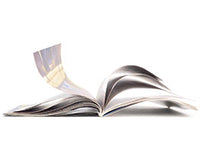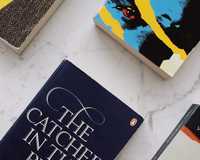When it comes to creating professional, visually appealing printed materials, saddle stitch booklet printing stands out as one of the most popular and cost-effective binding methods. Whether you’ve admired a sleek corporate brochure, flipped through an event program, or paged through a glossy catalog, chances are you’ve encountered this versatile technique. Saddle stitching provides a simple yet effective way to bind booklets, offering businesses, organizations, and individuals a high-quality finish for various marketing and informational needs.
But what exactly is saddle stitch booklet printing, and how can it elevate your marketing materials from "meh" to marvelous? This comprehensive guide will cover the ins and outs of this binding method, explaining its process, uses, advantages, limitations, and how it compares to other popular binding techniques.
From understanding the types of materials you can use to exploring their applications in different industries, saddle stitching offers a practical and professional solution for anyone looking to make their printed materials shine. Ready to dive in and learn how you can use saddle stitch booklet printing to boost your projects? Let’s explore this printing method in detail.
What is Saddle Stitch Booklet Printing?
At its core, saddle stitch booklet printing is a method of binding where folded sheets of paper are nested one inside the other, and then stapled along the spine. The result is a clean, professional-looking booklet with a flat spine that’s easy to open and read. The "saddle stitch" name comes from the saddle-shaped piece of equipment used to hold the folded pages while the staples are inserted.
This binding method is ideal for projects with a smaller page count, typically ranging from 8 to 64 pages. Whether you're printing brochures, catalogs, or event programs, saddle stitching offers a durable, polished finish that’s both lightweight and easy to distribute.
Types of Saddle Stitch Booklets
Contrary to what some might think, saddle stitch booklets aren’t a one-size-fits-all solution. Depending on your project’s requirements, different types of saddle stitch bindings serve specific purposes:
- Standard Saddle Stitch: The most common type, where pages are folded and stapled along the center fold.
- Loop Saddle Stitch: A variation of standard stitching that includes wire loops extending beyond the spine, allowing the booklet to be hung or inserted into binders.
- Butterfly Saddle Stitch: This method allows the pages to open completely flat, making it ideal for instruction manuals, large maps, or any materials that need a continuous view across pages.
Each type of saddle stitching serves a unique function depending on the layout and intended use of the booklet. Whether you need a practical solution for a corporate manual or a visually appealing marketing brochure, there’s a type of saddle stitch that will meet your needs.
The Process of Saddle Stitch Booklet Printing
Ever wondered how a beautifully finished saddle stitch booklet comes to life? It’s a step-by-step process that involves precision, design, and technical expertise. Here’s how it works:
- Design: The journey begins with your creative vision. A layout is designed for the booklet, typically with an even number of pages.
- Printing: Once the design is finalized, the pages are printed using high-quality printing methods, ensuring vibrant colors and crisp images.
- Folding: The printed sheets are folded in half to create what’s known as a "signature." Each signature is a group of pages that will be bound together.
- Collating: The folded sheets are then stacked in the correct sequence, ensuring the pages follow the right order.
- Stapling: Two or more staples are inserted along the fold of the booklet (the spine), holding the pages securely in place.
- Trimming: After binding, the edges of the booklet are trimmed to create a clean, uniform look.
This process, though simple, results in a professional, high-quality product that is perfect for a wide variety of applications.
Materials Used in Saddle Stitch Booklet Printing
Saddle stitching isn’t limited to plain paper. One of the biggest advantages of this method is its flexibility in terms of materials. Here are some common types of paper used in saddle stitch booklet printing:
- Glossy Paper: Often used for catalogs, brochures, or promotional materials, glossy paper enhances the colors and gives the booklet a sleek, shiny finish.
- Matte Paper: Ideal for a more understated, professional look, matte paper offers a premium feel without the shine.
- Textured Paper: Adds a tactile dimension, perfect for art portfolios or any booklet designed to make an impression through touch as well as sight.
- Recycled Paper: Eco-friendly and stylish, recycled paper is an excellent choice for companies with sustainability goals.
- Cardstock: Thicker and more durable, cardstock is often used for booklets that need to withstand frequent handling, such as product catalogs or instruction manuals.
This variety of paper options allows you to choose the perfect finish for your booklet, depending on its purpose and audience.
Applications of Saddle Stitch Booklets
Saddle stitch booklets are incredibly versatile and can be found in almost every industry. Here are some of the most common applications:
- Corporate Brochures: Used to showcase products or services, saddle stitch brochures are easy to distribute at trade shows or meetings.
- Event Programs: Saddle stitch booklets are ideal for creating event programs, whether for conferences, weddings, or live performances.
- Educational Materials: Schools and universities frequently use saddle stitch for student handbooks, course materials, or instructional guides.
- Product Catalogs: Businesses use saddle-stitched catalogs to present their products professionally, and organized.
- Nonprofit Organizations: Informational brochures and fundraising materials are often saddle-stitched for an economical yet professional appearance.
- Art Portfolios: Artists and designers use saddle stitch booklets to showcase their work in a polished, easily accessible format.
Advantages of Saddle Stitch Booklet Printing
There are several reasons why saddle stitch booklet printing is such a popular choice for businesses and individuals:
- Cost-Effective: Saddle stitching is one of the most affordable booklet binding methods available, making it ideal for small to medium-sized projects.
- Fast Turnaround: The straightforward process means that booklets can be printed and bound in a matter of days.
- Lightweight and Portable: These booklets are easy to distribute by hand or mail, making them perfect for marketing campaigns or event handouts.
- Professional Appearance: Saddle stitch booklets have a clean, polished look that exudes professionalism, regardless of the project’s purpose.
- Lies Flat: When opened, saddle-stitched booklets lie relatively flat, making them easy to read or write on.
- Eco-Friendly: The minimal use of materials (just paper and staples) means saddle stitch booklets are more environmentally friendly than other binding methods.
Limitations of Saddle Stitch Booklet Printing
While saddle stitching offers many benefits, it’s not without its limitations:
- Page Count Limit: Saddle stitch booklets typically max out at 64 pages. Any more, and the booklet won’t close properly, and pages may not align correctly.
- Durability: Saddle stitching is less durable than other binding methods, such as perfect binding or hardcover binding, making it better suited for short-term use.
- Paper Thickness: Thicker paper can make saddle stitching difficult or impossible, as it requires the paper to fold cleanly in half.
What Types of Materials Can Be Saddle Stitched?
Saddle stitch binding works well with a wide range of materials, offering different looks and textures depending on the type of paper used. Some common options include:
- Glossy Paper: Offers a sleek, shiny finish and enhances color vibrancy, ideal for marketing materials.
- Matte Paper: More understated and gives a premium feel.
- Textured Paper: Adds a tactile experience, great for unique or high-end booklets.
- Recycled Paper: An eco-friendly option for companies focusing on sustainability.
- Cardstock: Offers a sturdier feel and a more durable product, often used for booklets that need to be handled frequently.
Where Are Saddle Stitch Booklets Used?
This type of booklet printing is ideal for:
- Corporate Brochures: Highlighting your company’s products, services, or portfolio.
- Annual Reports: Compact and professional, easy to distribute.
- Event Programs: For events, trade shows, or conferences where you need lightweight, easy-to-read handouts.
- Educational Materials: Used in schools for handbooks, manuals, and course materials.
- Catalogs and Product Guides: To showcase products or services in a visually appealing format.
- Art Portfolios: Professional and lightweight for artists to present their work.
How Does Saddle Stitch Compare to Other Binding Methods?
Compared to other booklet binding methods, saddle stitching is generally more affordable and simpler:
- Perfect Binding: While perfect binding gives a higher-end appearance, it is costlier and takes longer to produce. Saddle stitching is faster and more economical.
- Spiral Binding: Spiral binding allows for a 360-degree page turn, but it lacks the polished, professional look of saddle stitching.
- Hardcover Binding: Ideal for books with a long lifespan, hardcover binding is significantly more expensive. Saddle stitching is ideal for short-term or lightweight materials.
FAQs about Saddle Stitch Booklet Printing
- What is the ideal page count for saddle stitching?
- The sweet spot is between 16 and 32 pages, though it can handle up to 64 pages.
- Can saddle stitch booklets be printed on both sides of the paper?
- Yes, most saddle stitch booklets are printed double-sided to maximize space.
- Is saddle stitch booklet printing eco-friendly?
- Yes, it uses minimal materials (staples and paper), making it an eco-friendly option, especially when paired with recycled paper.
- How long does the printing process take?
- Standard printing times range from 3-5 business days, though this can vary based on the complexity of the project.
- Can I add more pages after printing?
- No, once a saddle-stitched booklet is bound, additional pages cannot be added.
Conclusion
Saddle stitch booklet printing is a versatile, affordable, and professional binding method that works for a variety of printed materials. From corporate brochures and product catalogs to educational materials and event programs, saddle stitching provides a polished finish that enhances your project’s presentation. Whether you're printing 10 or 1,000 copies, this method offers a balance of cost-effectiveness and visual appeal that’s hard to beat.
Ready to take your printed materials to the next level? Consider saddle stitch booklet printing for your next project and see how this simple yet effective binding method can make your brochures, catalogs, and booklets stand out.





